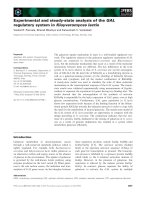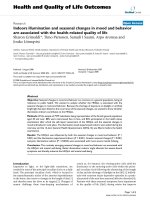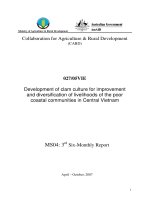Annuities and Other Retirement Products: Designing the Payout Phase (Directions in Development)_3 pdf
Bạn đang xem bản rút gọn của tài liệu. Xem và tải ngay bản đầy đủ của tài liệu tại đây (395.06 KB, 23 trang )
6
Gamma and theta
It should be apparent after reading the previ-
ous chapter that delta is an indispensable tool for
understanding an option’s behaviour. But because
an option’s delta changes continually with the
underlying, we need to be able to assess its own
rate of change. Gamma quantifies the rate of change of the delta with
respect to a change in the underlying.
To understand gamma is to understand how quickly or slowly a delta can
change. Suppose XYZ is trading at a price of 100, and there are just two
hours until the front-month options contract expires. The typical daily
range of XYZ is two points, so we expect it to be between 99 and 101 at
the time of expiration.
Now suppose that XYZ starts to move erratically, and for the next two
hours it trades between 99 and 101. During this time, what is the delta
of the expiring 100 call? If XYZ settles below 100, the 100 call will expire
worthless, with a delta of zero. If XYZ settles above 100, the call will close
at parity, with a delta of 1.00.
During these last two hours it would have been pointless to calculate
the delta because it is changing so rapidly. This rapid and most extreme
change of delta, however, is an example of the highest possible gamma
that an option can have.
If we consider the out-of-the-money options in the same contract month,
such as the 105 calls and the 95 puts, we can be almost certain that they
will expire worthless. Their deltas are zero and will not change. They have
no gamma. Likewise in-the-money, parity options such as the 90 calls
and the 110 puts have no gamma because their deltas will remain at 1.00
through expiration.
Gamma quantifies the
rate of change of the
delta with respect to a
change in the underlying
54 Part 1
Options fundamentals
The first situation above occasionally occurs, but most options con-
tracts expire well out-of or in-the-money. Nevertheless, several points
about gamma are illustrated. In any contract month, gamma is the high-
est with the at-the-money options, and it decreases as the strike prices
become more distant from the money, whether they are in-the-money or
out-of-the-money.
As a contract month approaches expiration, the gammas of both the at-
the-money options, and the options near-the-money, increase. The effect
of time decay, however, causes the gammas of the far out-of-the-money
and far in-the-money options to approach zero. Generally speaking, how-
ever, time decay least affects the gammas of options in the 0.10 and 0.90
delta ranges. This all becomes complicated, of course, by the fact that
deltas change with time. You should simply remember that as time passes,
the nearer an option is to the underlying, the more its gamma increases.
Table 6.1 is a typical example of a set of options with deltas and gammas
in one contract month:
90 days until expiration; implied volatility at 30 per cent; interest rate
at 3 per cent; options multiplier at $50, so multiply call and put values
times $50.
Table 6.1 December Corn at $3.80
Strike Call value
× $50
Call delta Put value
× $50
Put delta Gamma
320 63.00 0.90 3
1
/
4
0.10 0.003
340 47.00 0.80 7 0.20 0.005
360 33
7
/
8
0.67 14 0.33 0.007
380 22.00 0.53 22 0.47 0.008
400 15.00 0.40 35 0.60 0.007
420 8
5
/
8
0.27 48
1
/
2
0.73 0.006
440 5
1
/
2
0.19 65
1
/
4
0.81 0.005
The gamma-delta calculation is a matter of simple addition or subtraction.
Here, the December 400 call with a 0.40 delta has a gamma of 0.007. This
means that if the December futures contract moves up one point, from
380 to 381, the delta of the call will increase to 0.407, rounded to 0.41.
6
Gamma and theta 55
If the futures contract moves down one point, the delta of the same call
will decrease to 0.393, rounded to 0.39. Accordingly, if the futures contract
moves up 20 points, then the delta of the 400 call will increase by 0.14, to
0.54, the equivalent delta of the 380 call at present.
If the December futures contract moves down by one point, then the delta
of the December 340 put will increase by its gamma of 0.005, from 0.20 to
0.205 (or 0.21 rounded); if the futures contract moves up by one point, the
delta will decrease by 0.005.
Note that gamma describes the absolute change in delta, whether
increased or decreased.
An option’s gamma, like its delta, changes as the underlying changes. If
you calculate the new theoretical delta for the December 420 call over
an increase of 40 points in the futures contract (corn, like all commod-
ities, can be extremely volatile), the result will be (0.006 × 40) + 0.27 =
0.51. You should instead expect the new delta to be equivalent to that of
the present December 380 call at 0.53 This discrepancy is due to the fact
that the gamma is increasing from 0.006 to 0.008 as the futures contract
moves up. The gamma-delta calculation is therefore best applied to a small
change in the delta.
Table 6.2 lists the same set of options but with less time until expiration.
If we compare it with Table 6.1, the points previously made about gamma
become evident. With the passage of time, the deep in-the-money and far
out-of-the-money options have gammas that are unchanged to decreased,
while at-the-money and near-the-money options have increased gammas:
Table 6.2 December Corn at $3.80 × 5,000 bushels
Strike Call value Call delta Put value Put delta Gamma
320 60
1
/
8
0.99
1
/
8
0.01 0.001
340 41
1
/
8
0.92 1
1
/
4
0.08 0.005
360 24
5
/
8
0.76 4
3
/
4
0.24 0.01
380 12
1
/
2
0.51 12
1
/
2
0.48 0.013
400 5
3
/
8
0.28 25
1
/
4
0.72 0.011
420 1
7
/
8
0.12 41
7
/
8
0.83 0.006
440 0
5
/
8
0.04 60
1
/
2
0.96 0.003
56 Part 1
Options fundamentals
Gamma can be thought of as the heat of an option. It tells us how fast our
option’s delta, or our equivalent underlying position, is changing.
30 days until expiration; implied volatility at 30 per cent; interest rate at
3 per cent; options multiplier at $50.
Positive and negative gamma
Because gamma determines the absolute (increased or decreased) change
in delta, and delta determines the absolute change in an option’s
price, gamma helps us determine our exposure to absolute underlying
movement.
Remember that a long call is an alternative to a
purchase of the underlying. It is a hedge for under-
lying movement in either direction: it gains price
appreciation on the upside, and it offers price
protection on the downside. A long call yields a
benefit when the market moves; its value has a positive correlation with
market movement.
The same is true for a long put as an alternative to a sale or short position
in the underlying. If you buy a put instead of selling your stock, you’ll be
very content if the stock makes a large move in either direction.
Positive correlation with market movement is commonly known as posi-
tive gamma. Just as a long at-the-money option has the most profit/savings
potential, a long at-the-money option has the most positive gamma.
Conversely, negative correlation with market movement is known as
negative gamma. If you sell an at-the-money call instead of selling
your stock, you’ll be disappointed if the stock moves above or below the
amount of the call sale. If you sell an at-the-money put instead of buying
stock, you may curse your luck if the stock moves outside the range of the
sale price. Should this be unclear, imagine yourself with a potential XYZ
position at 100 and with a potential 100 call or put priced at 4.
The following discussion becomes somewhat more advanced. You may
return to it later, or have a glance now.
Gamma helps us
determine our exposure
to absolute underlying
movement
6
Gamma and theta 57
Gamma and volatility trading
The gamma calculation is particularly useful to those who trade volatility,
i.e. absolute price movement or price movement in either direction.
Long options can be combined in order to profit from absolute market move-
ment, and short options can be combined to profit from a static market.
If we use the set of options in Table 6.2, a position of long 1 December
380 call plus long 1 December 380 put will have a total positive gamma of
+0.013 × 2, or +0.026. This position is known as a long straddle, and it will
profit from an underlying move in either direction greater that the pur-
chase price of 12.5 + 12.5 = 25. It has two break-even levels, at 405 and 355.
Because this position is long both a call and a put, the gamma figure tells
us that its combined delta increases by 0.026 for each 1 point increase in
the underlying: the call increases its delta by 0.013, and the put decreases
its delta by 0.013. The gamma figure also tells us that for each 1 point
decrease in the underlying, the combined delta decreases by 0.026: the put
increases its delta by 0.013, and the call decreases its delta by 0.013.
In other words, as the underlying rallies, this position becomes longer, and
as the underlying breaks, this position becomes shorter. As confirmed by
the break-even levels, the long straddle profits from increased volatility, or
absolute price movement.
Conversely, the opposite position, a short straddle, will have a negative
gamma position of –0.026, and will profit if December Corn remains
between 355 and 405. These two positions are discussed further in the
chapter on straddles (Chapter 11).
The gamma calculation is useful to market-makers who carry large posi-
tions on their books. The above gamma reading of +/–0.026 indicates
more exposure to market movement than, for example, +/–0.0.11, which
would be obtained by buying or selling both the December 420 call and the
December 340 put. Here, the break-even levels are 423.13 and 336.88. This
position is known as the strangle, and it is also discussed in Chapter 11.
Positive and negative gamma help to quantify the risk/return potential of
a position with respect to absolute market movement.
58 Part 1
Options fundamentals
Theta
Compared to gamma and delta, theta is a straight-
forward concept. The theta of an option is the
amount that the option decays in one day. A
short options position receives income from time
decay and therefore has positive theta. A long
options position incurs an expense from time decay and therefore has
negative theta.
Tables 6.3 and 6.4 are similar to the previous Tables 6.1 and 6.2, but they
include the daily theta numbers for all the contracts listed. Here, the theta
figures are expressed in actual dollars and cents (they can also be expressed
in options ticks):
90 days until expiration; implied volatility at 30 per cent; interest rate
at 3 per cent; options multiplier at $50, so multiply call and put values
times $50.
Table 6.3 December Corn at $3.80
Theta in $/day
Strike Call
value ×
$50
Call
delta
Put
value ×
$50
Put
delta
Gamma Theta ($
per day)
320 63.00 0.90 3.25 0.10 0.003 2.75
340 47.00 0.80 7.00 0.20 0.005 4.5
360 33.88 0.67 14.00 0.33 0.007 5.5
380 22.00 0.53 22.00 0.47 0.008 6.65
400 15.00 0.40 35.00 0.60 0.007 6.0
420 8.63 0.27 48.50 0.73 0.006 5.5
440 5.50 0.19 65.50 0.81 0.004 4.0
30 days until expiration; implied volatility at 30 per cent; interest rate at
3 per cent; options multiplier at $50.
The theta of an option
is the amount that
the option decays
in one day
6
Gamma and theta 59
Table 6.4 December Corn at $3.80 × 5,000 bushels
Strike Call
value
× $50
Call
delta
Purt
value
× $50
Put
delta
Gamma
per
point
Theta ($
per day)
320 60.13 0.99 0.13 0.01 0.001 0.60
340 41.13 0.92 1.25 0.08 0.005 4.20
360 24.63 0.76 4.75 0.24 0.01 9.00
380 12.50 0.51 12.50 0.48 0.013 11.50
400 5.38 0.28 25.25 0.72 0.011 10.00
420 1.88 0.12 41.88 0.83 0.006 5.50
440 0.63 0.04 60.50 0.96 0.003 2.25
As we said in Chapter 3, all options lose their value at an accelerated rate
as they approach expiration. The at-the-money options, the 380s, have
the most increase in theta because they contain the most time premium.
Those nearest the money, the 360s and the 400s, also have increased
theta. The far out-of-the-money and deep in-the-money options can have
decreased theta, but this is because they contain only a small amount of
time premium with 30 DTE.
Use and abuse of theta
Theta quantifies the expense of owning, or the income from selling, an
option for a day of the option’s life. You may have an outlook for move-
ment in a particular underlying. What is the cost of a long options
position for the duration of your outlook? If your outlook is for a stable
market, what is your expected return from a short options position during
this time period?
The subject of theta gives rise to a few words of caution. It is tempting
to sell options simply to collect money from time decay. This strategy
contains a hidden risk. It can become habitual because it often works
on a short- and medium-term basis. In the long term, however, it usu-
ally fails. The reason is that it ignores the basis of options theory: that
60 Part 1
Options fundamentals
time premium is a fair exchange for volatility coverage. Many traders
have gone bust by ignoring this basic principle. To sell options in such
a manner is to ignore probability, and to hope that you are out of the
market when it eventually moves.
A story about theta
The following story tells what can go wrong with a short options position,
but also how trouble can be avoided.
A few years ago I worked for one of the more prominent traders in index
options in Chicago. His strategy was to sell index calls and hedge them
with long S&P 500 futures contracts. We were in a bear market. Stocks
and the index implied volatility were both in a downtrend. The trader I
worked for, Bobby, routinely leaned short, i.e. his overall delta position
was negative from day to day. He had made substantial profits in this way.
I did then as I do now, follow a number of technical indicators. One of
them was the 200-day moving average. The S&P 500 was holding at
this level after an extensive decline, and I became worried that Bobby’s
strategy, which had worked so well for many months, might have run
its course, at least for the time being. Because I was new to the business,
Bobby would have none of my beginner’s advice. After all, he was my
boss, and he had recently made a substantial amount of money. He had
also substantially increased the size of his positions.
A week or two later, I was on the floor early for a government economic
indicator. The report was bullish, bonds were up, and so was the call for
stocks. I phoned in my report, and Bobby greeted the news with dead
silence. A few minutes later, he joined me in the pit, and the stock market
gapped open higher with no chance to cover his position. We stood
there for about half an hour just watching the order flow and the indexes
amid frenetic trading. Then things started to quiet down. The indexes
downticked a little, but they weren’t picking up momentum.
Bobby made his first trades, big ones – he sold calls. I tapped him on the
shoulder and tried to say, ‘Bobby, they’re not going down,’ but he cut
me off by saying, ‘Shut up and gimme the count,’ meaning calculate his
position. Several minutes later, the market made its second move, fast
and higher. Again, there was no chance to cover. It levelled off at about
half again the distance of the first move. Bobby then covered as best as he
could by buying in calls, which were well bid, and by buying futures. He
left the pit without saying a word, and I stayed on to tally his position.
6
Gamma and theta 61
A half hour later, I joined him upstairs in his office to give him my report.
He was sitting in his chair, staring through his trading screen. He didn’t
hear a word I was saying; he was speechless and catatonic. He had lost a
great deal of money. I knew his position was safe for the moment, so I left
the office.
There are a few lessons to be learned from this story. One is to know why
your strategy is working. Of course you’re talented, astute and you work
hard, but is your style of trading or your strategy particularly suited to a
certain kind of market? What happens if the market changes its character?
Another lesson is the converse. Perhaps the strategies that you’re most
comfortable with aren’t the ones that profit in the current market. Can
you adapt? If you don’t feel comfortable with a different style or strategy,
then by all means take a break from the market.
Finally, remember that options are derivatives. Once you’re in the business
a while, it becomes easy to lose touch with the fundamental and techni-
cal analyses of underlying contracts. Lack of awareness sooner or later
proves costly.
The trader I worked for eventually worked his way back into the market,
and has done very well in recent years. We’ve still never discussed the 200-
day moving average.
7
Vega
Often in an options market circumstances arise that cause the volatil-
ity of the underlying to increase or decrease suddenly. This may be the
result of the inception or conclusion of an unfor-
seen market event. During such circumstances the
implied volatility of each options contract month
reacts to a different degree, and this in turn affects
the price of each option of each contract month
to a different degree. Under these as well as more
usual circumstances there is a need to quantify
the effect of a change in implied volatility on the price of a particular
option. Vega is the amount that an option changes if the implied volatility
changes by one percentage point.
Vega itself can be expressed in either options ticks or in an actual currency
amount. Table 7.1 shows a set of options with their vegas for one contract
month. The vegas are expressed in dollars then rounded into ticks.
30 days until expiration
Implied volatility at 30 per cent
Interest rate at 3 per cent.
An increase in implied volatility leads to an increase in options premiums,
while a decrease in implied volatility has the opposite effect. If the current
implied volatility increases from 30 per cent to 31 per cent, the value of
the December 380 call increases from 12
1
/
2
to 13. If the implied volatility
decreases from 30 per cent to 29 per cent, the value of the December 380
call decreases from 12
1
/
2
to 12.
Vega is the amount
that an option changes
if the implied volatility
changes by one
percentage point
64 Part 1
Options fundamentals
Table 7.1 December Corn at $3.80 × 5,000 bushels
Options multiplier at $50
Strike Call
value
× $50
Call
delta
Put value
× $50
Put
delta
Gamma
per point
Theta ($
per day)
Vega ($
per ivol
point)
Vega
(ticks)
320 60
1
/
8
0.99
1
/
8
0.01 0.001 0.60 1.4 0
340 41
1
/
8
0.92 1
1
/
4
0.08 0.005 4.20 5.7 0.13
360 24
5
/
8
0.76 4
3
/
4
0.24 0.01 9.00 18.5 0.38
380 12
1
/
2
0.51 12
1
/
2
0.48 0.013 11.50 21.0 0.50
400 5
3
/
8
0.28 25
1
/
4
0.72 0.011 10.0 21.5 0.50
420 1
7
/
8
0.12 41
7
/
8
0.83 0.006 5.50 15.0 0.38
440
5
/
8
0.04 60
1
/
2
0.96 0.003 2.25 6.5 0.13
Note that the vega, or the number of options ticks, is multiplied by the
number of percentage points that the implied volatility changes. The
above implied may increase 3 per cent (commonly meaning 3 percentage
points), from 30 per cent to 33 per cent. The new value of the December
380 call will then be 14.
For out-of- and in-the-money options, the vega itself increases as the
implied increases, and it decreases as the implied decreases. Therefore with
these options the vega calculation is most accurate for a small change in
the implied. For at-the-money options, the vega remains constant through
changes in the implied.
At-the-money options have larger vegas than out-of- and in-the-money
options. This is because a change in volatility increases or decreases their
range of coverage more than out-of- and in-the-money options. Their
value becomes increased or decreased accordingly.
Table 7.2 shows a set of longer-term options, with their vegas, on the same
underlying:
90 days until expiration; implied volatility at 30 per cent; interest rate at 3
per cent; options multiplier at $50, so multiply call and put values times $50.
7
Vega 65
Table 7.2 December Corn at $3.80
Theta in $/day
Strike Call
value
× $50
Call
delta
Put value
× $50
Put
delta
Gamma
per point
Theta ($
per day)
Vega ($
per ivol
point)
Vega
(ticks)
320 63.00 0.90 3
1
/
4
0.10 0.003 2.75 25.0
1
/
2
340 47.00 0.80 7.00 0.20 0.005 4.50 25.0
1
/
2
360 33
7
/
8
0.67 14.00 0.33 0.007 5.50 35.5
3
/
4
380 22.00 0.53 22.00 0.47 0.008 6.65 37.5
3
/
4
400 15.00 0.40 35.00 0.60 0.007 6.00 37.5
3
/
4
420 8
5
/
8
0.27 48
1
/
2
0.73 0.006 5.50 25.0
1
/
2
440 5
1
/
2
0.19 65
1
/
4
0.81 0.005 4.00 25.0
1
/
2
The vega of an option increases with the time until expiration. This is
because an increase in implied volatility over a longer term necessitates
a greater increase in the options premiums. Consequently, if the implied
volatility increases equally for both a near- and a long-term contract, the
options in the latter will increase more.
A long options position profits from an increase in implied volatility, and
therefore it has a positive vega. A short options position profits from a
decrease in implied volatility, and therefore it has a negative vega.
Vega and implied volatility trends
Practically speaking, the implied volatility of long-term contracts is more
stable than those of near-term contracts. Front-month implied volatility is
the most reactive to current events, or current non-events.
In quiet markets, the front-month implied can trend lower and lower
for months in anticipation of continued conditions. Each point that the
implied decreases in turn multiplies, by the vega, the number of options
ticks that the options’ values decrease. The frustration of, and the risk to,
the premium holders becomes almost unbearable as their accounts dimin-
ish, while the premium sellers nonchalantly collect their time decay.
66 Part 1
Options fundamentals
If an unexpected event shocks the market, the front-month implied can
leap 5, 10, 30 or more percentage points within minutes. As the vegas
become multiplied by the increase in the implied volatility, even small
positions take on almost unmanageable proportions. The premium hold-
ers become vindicated, while the premium sellers see months of profits
eliminated.
Risk/return of vega
Because at-the-money options have the largest vegas, they are the most
exposed to a change in implied volatility. All options, of course, face this
exposure. In quiet markets, a short options position can profit not only
from time decay, but also from a decline in the implied. In active markets,
a long options position can profit from an increase in the implied that
more than offsets the cost of time decay.
It is important to know how much the vegas of options on a particular
contract can be affected by changes in volatility, and for that you need
to research the past historical and implied volatility ranges. Most data
vendors, the exchanges and many websites have this information. For
example, if you want to know how the crash of 1987 and the grinding
retracement of 1988 affected OEX implieds, how in turn the implieds mul-
tiplied the vegas, and how in turn the vegas affected the options prices,
consult the CBOE.
part
2
Options spreads
Introduction
Spreading risk
‘I’m bullish, what do I do?’ Occasionally I am asked this question, and
I usually begin my response with another question: ‘How much risk do
you want to take?’ In the options business there are many ways of taking
a position, and they all have varying degrees of risk. As with all kinds of
investments, there is a risk/return trade-off. High risk corresponds to high
return, while low risk corresponds to low return. The advantage of options
spreads is that each investor can take the amount of risk that he is able to
justify and manage. This part outlines the major strategies that spread risk.
These strategies can be traded on all the exchanges, and, with few excep-
tions, they can be traded in one transaction.
At the outset, it is important to know what risks you want to spread.
Premiums may be too high to justify an outright options purchase. The
potential for unlimited risk from a short call or put position may be unjus-
tified, even though premiums are at a high and
declining level. Your outlook may be for a direc-
tional move, but it may be uncertain of the extent.
The market may be due for a large move but the
direction may be difficult to assess. Implied volatili-
ties may be decreasing but they may be subject to frequent, upward spikes.
You may want to buy a short-term option, but its cost in terms of time
decay may be too great. These are just a few of the reasons for spreading risk.
Most options spreads can be classified as either directional or volatility
spreads. Directional spreads are those that profit from either bullish or
bearish market movement. Volatility spreads profit from either increased
or decreased absolute market movement, regardless of direction.
At the outset, it is
important to know what
risks you want to spread
70 Part 2
Options spreads
Any spread has the opposite risk and return potential depending on
whether it is bought or sold.
Below is an index of the major spreads. It will serve as a quick reference
in selecting strategies. In a few cases the terms that are applied to these
spreads vary, but these will be noted. If you are first starting to trade, or if
this is your first reading, focus on the spreads marked with an asterisk (*),
because they have the least, and most manageable, risk.
Index of spreads
Bull spreads Bear spreads
* long call spread 74 * short call spread 76
* short put spread 80 * long put spread 78
long 1×2 call spread 85 long 1×2 put spread 88
long call ladder 91 long put ladder 94
long call, short put combo 101 long put, short call combo 104
* long OTM call butterfly 137 * long OTM put butterfly 138
* long OTM call condor 141 * long OTM put condor 144
* long diagonal call spread 160 * long diagonal put spread 160
Volatile market spreads Stationary market spreads
long straddle 110 short straddle 114
long strangle 116 short strangle 118
* long iron butterfly 121 * short iron butterfly 124
short ATM butterfly, call or put 136 * long ATM butterfly, call or put
131, 135
* long iron condor 128 * short iron condor 125
* short ATM put condor 146 * long ATM put condor 145
* short ATM call condor 147 * long ATM call condor 143
covered write 151
long calendar spread 157
ATM = at-the-money; OTM = out-of-the-money.
8
Introduction 71
Terms to use when placing spread orders
Whenever you place an order for one of these spreads, omit the jargon.
It is most important to know the price at which you want to trade the
spread. Then, you must know the prices of the individual options, or the
pieces, that you want to trade.
When you ring your broker, state that you are
placing an order for an options spread, and state
the stock or other underlying. Next, specify the
following: buy or sell, quantity, month, strike
price, and call(s) or put(s). Do this for each options
strike. Next, specify the net debit or credit for one spread. Then, specify
the total debit or credit for the trade. Make sure your broker repeats all the
specifications to you. Last of all, use the jargon, but only if you and your
broker have previously agreed on the terms. Your conversation with your
broker should sound like the following:
You: Hi, I want to place an options spread order in IBM.
Broker: Go ahead.
You: On a spread buy 5 July130 calls, and sell 5 July 135 calls for a net
debit of 1.27 times 5. Total debit is 6.35. [You should know that 6.35
equals $635.00.]
Broker: Checking, in IBM options you are buying 5 July 130 calls, and selling
5 July 135 calls as a spread, for a debit of 1.27 times 5. Your total
debit is 6.35.
You: Yes, that’s correct.
Broker: Working, I’ll call you back.
When your broker calls you back to confirm, he or she should specify all
of the above plus the prices of each option.
Broker: Hi, you’re filled on your spread.
You: Good, read it off.
Broker:
On a spread in IBM you bought 5 July 130 calls, and sold 5 July 135
calls for a debit of 1.27 times 5. Your total debit is 6.35. You paid 2.87
for 5 of the July 130 calls, and you sold 5 of the July 135 calls at 1.60.
You: Yes, that’s correct.
Broker: Checking, you paid 1.27 for 5 July 130–135 call spreads.
You: Yes, I paid 1.27 to go long (to buy) 5 July 130–135 call spreads.
Whenever you place
an order for one of
these spreads,
omit the jargon
72 Part 2
Options spreads
Broker: Can you confirm that again?
You: Have a nice day, wise guy.
Note that when reporting the prices of the options, your broker should use
the following terms:
O
when buying: price for quantity
O
when selling: quantity at price.
These terms avoid confusion, and they have been used for many years on
most of the major exchanges, including the CBOT and the LIFFE. Learn to
use them.
Advice for beginners
Before we begin our discussion of spreading, here are two pieces of advice:
O
The first is not to change your risk/return profile in order to reduce
your premium outlay or to pay less commissions. Trade an options
position because your outlook tells you it is the best position to take
under the current market conditions. Specifically, selling extra options
may reduce the cost of your spread, or failing to buy protective options
may reduce the amount of your brokerage bill, but in both cases, you
incur added and unjustifiable risk.
O
Second, if you are new to trading options, do not take a position that is
net short an option or options. There are many ways to trade from the
short side without taking unlimited, or practically unlimited, risk. They
all involve the purchase of one or more risk limiting options. Each
short option should be covered by a long option.
It is helpful to discuss the profit/loss potential
of spreads in terms of their value at expiration.
Practically speaking, however, you will most often
close a spread before expiration because you will
not want to exercise or be assigned to an underlying contract. You also do
not want pin risk.
Each short option
should be covered by a
long option
8
Call spreads and put spreads,
or one by one directional
spreads
Investors with a directional outlook often find the risks of a straight long
or short options position to be undesirable. A stock index may be at a his-
torically high level, and therefore an investor may want to sell calls or
buy puts in order to profit from a decline. But per-
haps the market is still too strong to sell ‘naked’
calls, i.e. short calls without a hedge. If premium
levels are high, then the investor may not want
to risk investing in a straight put purchase. A sen-
sible alternative is to spread the risk of a straight
options position by taking the opposite long or
short position at a strike price that is more distant
from the underlying.
For example, if XYZ is trading at 100, we may buy the 95 put and simul-
taneously sell the 90 put, thereby creating a long put spread, a bearish
strategy. If instead we are bullish, we may sell the 95 put and buy the 90
put, creating a short put spread.
Another bullish strategy is to buy the 105 call while selling the 110 call,
creating a long call spread. If instead we sell the 105 call while buying
the 110 call, we create a short call spread, an alternative bearish strategy.
These four spreads are also known as vertical spreads.
Spread the risk of a
straight options position
by taking the opposite
long or short position
at a strike price that
is more distant from
the underlying
74 Part 2
Options spreads
In practice, both strikes of the call or put spread are usually placed out-of-
the-money. The key to all these spreads is the option that is at, or nearest
to, the underlying. We will discuss each of them.
In addition, by spreading one option against the other, you are also
spreading cost against cost, so if one option is dear, then it is financed
by another that is dear. You also minimise your exposure to the Greeks. I
repeat: you minimise your exposure to the Greeks.
The profit/loss calculations that form the basis of these spreads can be
applied to any underlying in stocks, bonds, commodities or FX. For the pur-
pose of illustration, a set of options on a stock index is given in Table 8.1:
SPDR at 115.22
45 days until June expiration
Contract multiplier of $100
Table 8.1 SPY options
Strike
107 109 111 113 115 117 119 121 123
June calls
5.05 3.80 2.60 1.70 1.00 0.55
June puts
1.75 2.15 2.60 3.10 3.90 4.80
*Long call spread
Bullish strategy
The SPDR
1
(‘Spider’) is currently trading at 115.22. You may wish to pur-
chase the 117 call to profit from an upside move. It’s close to expiration,
time decay is costly, and the implied volatility is higher than it has been
recently, so an expenditure of 2.60 × $100, or $260 may seem too great.
You could sell the 119 call for 1.70 at the same time as you buy the 117
call, for a total debit of 0.90 or $90. Your short call then effectively finances
the purchase of your long call, and minimises your exposure to the Greeks.
1
S&P 500 ETF Trust. The options trade at Chicago’s CBOE. The SPDR is a mutual fund
based on the S&P 500. Just think of it as the S&P 500. The current open interest on this
options contract is a massive 13 million. In other words, everybody and his uncle trade
it. Because it’s 1/10th the size of the Spu’s, it’s affordable.
8
Call spreads and put spreads, or one by one directional spreads 75
With this spread, you have a potential buy at 117 and a potential sell at 119,
for which you pay a premium. Your analysis may indicate that the near-
term price gain for the SPDR is expected to be 119. You are willing to trade
unlimited upside potential for a reduced risk in your premium exposure.
This position is known as the long call spread because it is similar to a
long call.
2
In order to assess the profit/loss potential of the spread at expi-
ration, first the price of the spread is considered as a unit, 0.90.
The maximum profit is gained if the stock is at or above the higher strike,
or 119, at expiration. This is calculated as the difference between the strike
prices minus the cost of the spread, or (119 – 117) – 0.90 = 1.10.
The maximum loss of the spread is equal to its cost, or 0.90. This loss is
incurred if the stock is at or below the lower strike, or 117, at expiration.
The break-even level is the level at which an increase in the stock pays for
the spread. This is calculated as the lower strike price plus the cost of the
spread, or 117 + 0.90 = 117.90. Here is a summary of this spread’s profit/
loss at expiration:
Debit from long June 117 call: –2.60
Credit from short June 119 call: 1.70
–––––
Total debit: –0.90
Maximum profit: difference between strikes – cost of spread:
(119 – 117) – 0.90 = 1.10
Maximum loss: cost of spread: 0.90
Break-even level: lower strike + cost of spread: 117 + 0.90 = 117.90
The risk/return potential of this spread is maximum loss divided by
maximum profit, or 0.90/1.10 = 0.82. In other words, a risk of 0.82 has a
potential gain of 1.00, or 1.6 to 2.
3
Table 8.2 shows the expiration profit/loss for this spread.
In graphic terms, the expiration profit/loss can be illustrated as shown in
Figure 8.1.
2
This spread is also known as the bull call spread and the long vertical call spread.
3
In practice, I prefer to have a risk/return ratio of 0.5 or better unless I’m very bullish,
which I was when I looked at this spread. We’ll talk about R/R as we move on.
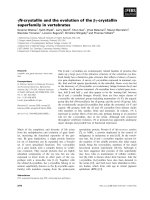
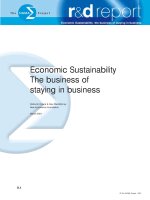
![Báo cáo khóa học: Selective release and function of one of the two FMN groups in the cytoplasmic NAD + -reducing [NiFe]-hydrogenase from Ralstonia eutropha pptx](https://media.store123doc.com/images/document/14/rc/gg/medium_ggg1394180403.jpg)

